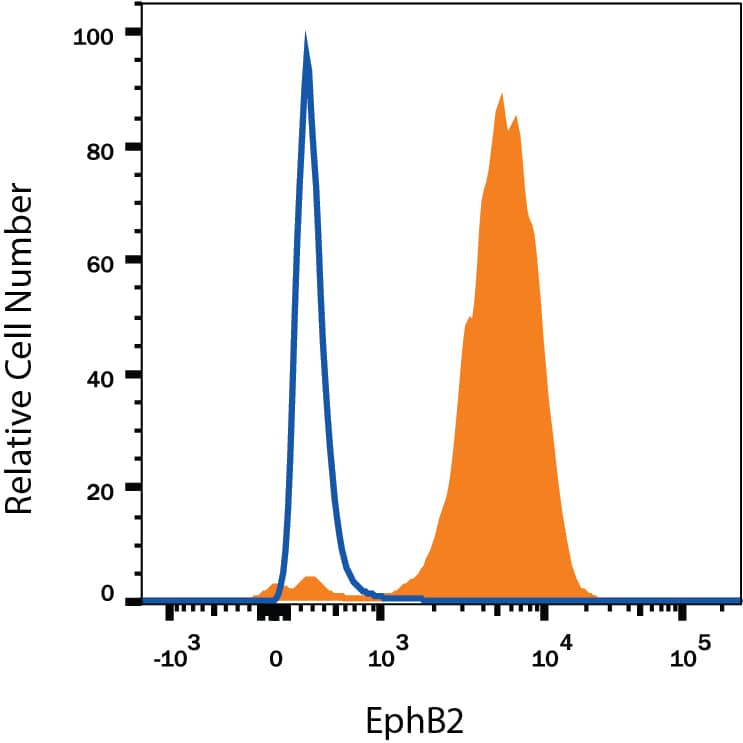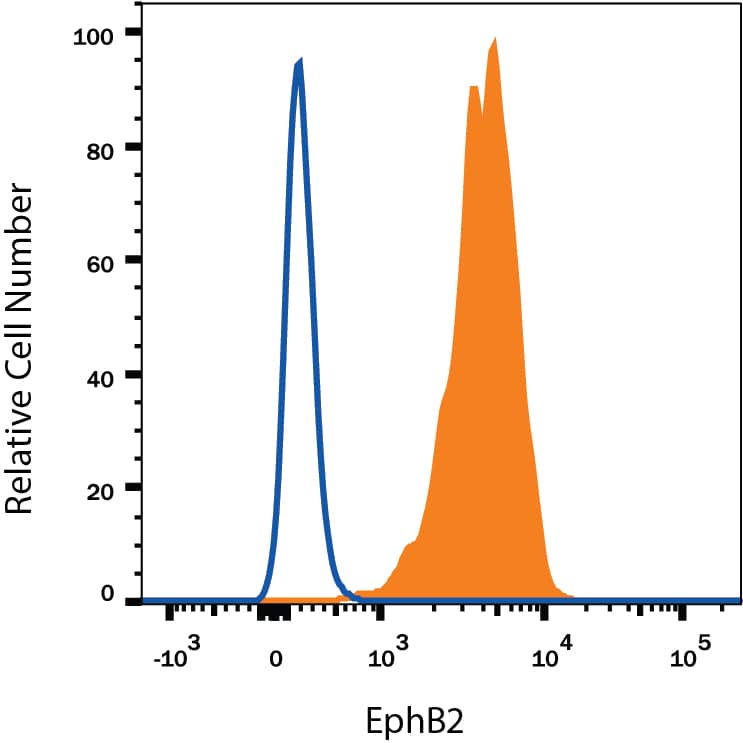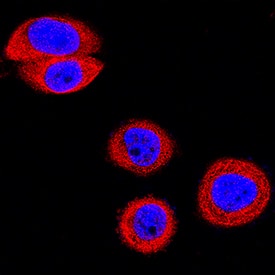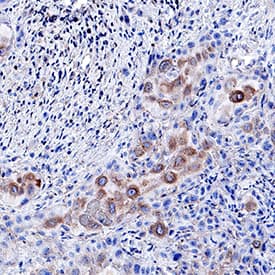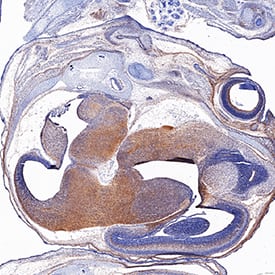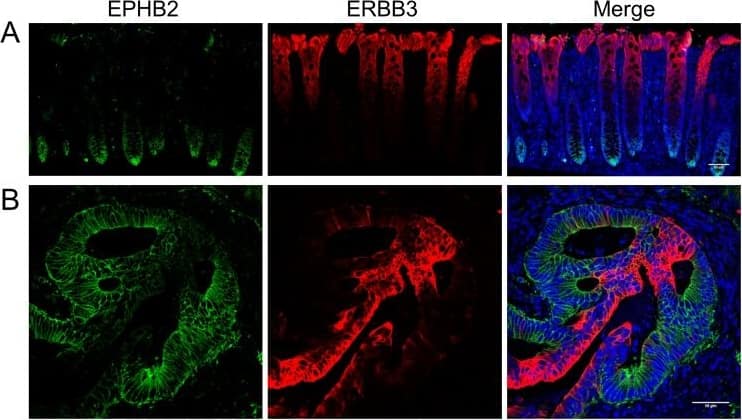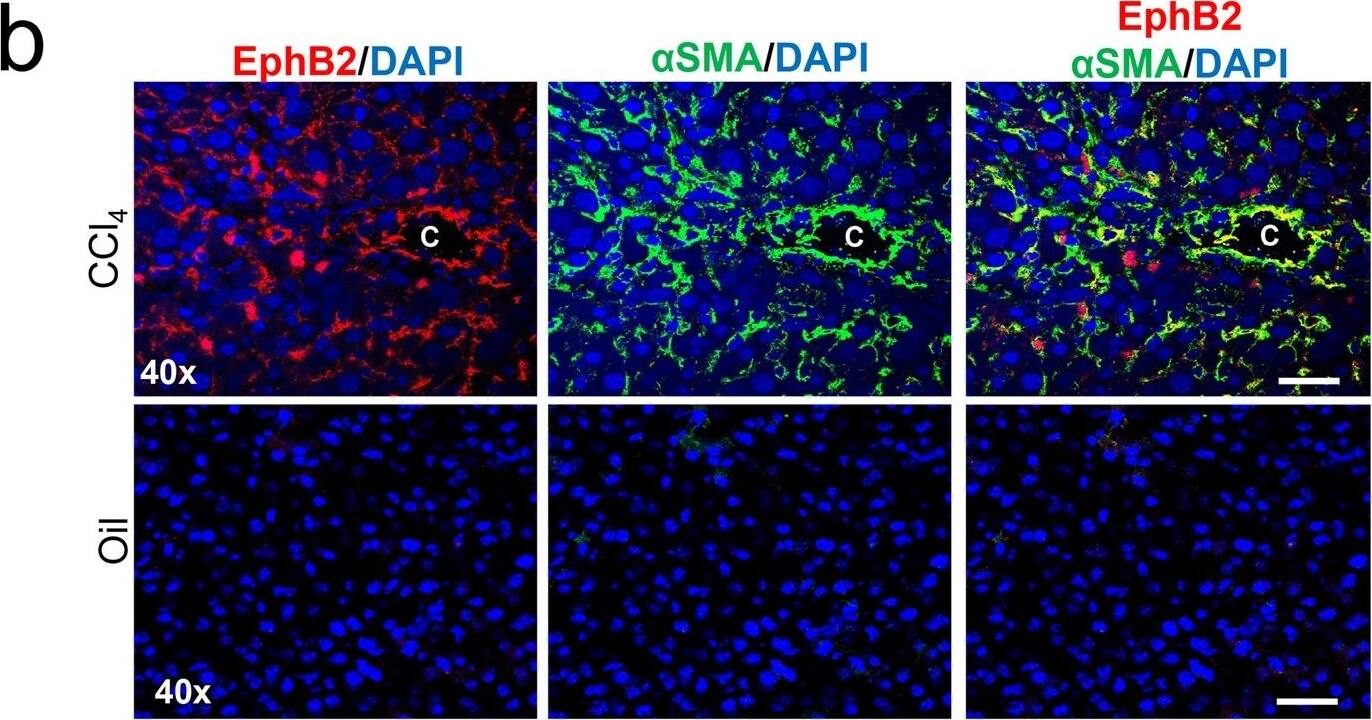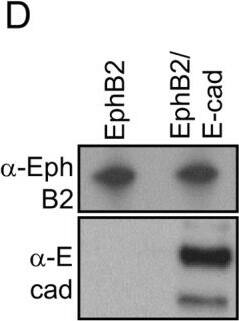Human/Mouse EphB2 Antibody
R&D Systems, part of Bio-Techne | Catalog # AF467


Key Product Details
Species Reactivity
Validated:
Cited:
Applications
Validated:
Cited:
Label
Antibody Source
Product Summary for Human/Mouse EphB2 Antibody
Specificity
Clonality
Host
Isotype
Scientific Data Images for Human/Mouse EphB2 Antibody
Detection of Recombinant Human and Mouse EphB2 by Western Blot.
Western blot shows 25 ng of Recombinant Human EphB2 Fc Chimera (Catalog # 5189-B2) and Recombinant Mouse EphB2 Fc Chimera (Catalog # 467-B2). PVDF Membrane was probed with 0.1 µg/mL of Goat Anti-Human/Mouse EphB2 Antigen Affinity-purified Polyclonal Antibody (Catalog # AF467) followed by HRP-conjugated Anti-Goat IgG Secondary Antibody (Catalog # HAF109). A specific band was detected for EphB2 at approximately 120 kDa (as indicated). This experiment was conducted under reducing conditions and using Immunoblot Buffer Group 3.Detection of EphB2 in COLO 205 Human Cell Line by Flow Cytometry.
COLO 205 human colorectal adenocarcinoma cell line was stained with Goat Anti-Human/Mouse EphB2 Antigen Affinity-purified Polyclonal Antibody (Catalog # AF467, filled histogram) or isotype control antibody (Catalog # AB-108-C, open histogram), followed by Phycoerythrin-conjugated Anti-Goat IgG Secondary Antibody (Catalog # F0107). View our protocol for Staining Membrane-associated Proteins.Detection of EphB2 in D3 Mouse Cell Line by Flow Cytometry.
D3 mouse embryonic stem cell line was stained with Goat Anti-Human/Mouse EphB2 Antigen Affinity-purified Polyclonal Antibody (Catalog # AF467, filled histogram) or isotype control antibody (Catalog # AB-108-C, open histogram), followed by Phycoerythrin-conjugated Anti-Goat IgG Secondary Antibody (Catalog # F0107). View our protocol for Staining Membrane-associated Proteins.Applications for Human/Mouse EphB2 Antibody
CyTOF-ready
Flow Cytometry
Sample: COLO 205 human colorectal adenocarcinoma cell line and D3 mouse embryonic stem cell line
Immunocytochemistry
Sample: Immersion fixed MDA-MB-468 human breast cancer cell line
Immunohistochemistry
Sample: Immersion fixed frozen sections of embryonic mouse brain (15 d.p.c.), immersion fixed paraffin-embedded sections of human esophageal squamous cell carcinoma, and immersion fixed frozen sections of mouse embryo (13 d.p.c.)
Simple Western
Sample: COLO 205 human colorectal adenocarcinoma cell line and MBA‑MB‑468 human breast cancer cell line
Western Blot
Sample: Recombinant Human EphB2 Fc Chimera (Catalog # 5189-B2) and Recombinant Mouse EphB2 Fc Chimera (Catalog # 467-B2).
Reviewed Applications
Read 9 reviews rated 4.3 using AF467 in the following applications:
Formulation, Preparation, and Storage
Reconstitution
Formulation
*Small pack size (-SP) is supplied either lyophilized or as a 0.2 µm filtered solution in PBS.
Stability & Storage
Background: EphB2
EphB2, also known as Cek5, Nuk, Erk, Qek2, Tyro5, Sek3, Hek5, and Drt (1), is a member of the Eph receptor family which binds members of the ephrin ligand family. There are two classes of receptors, designated A and B. Both the A and B class receptors have an extracellular region consisting of a globular domain, a cysteine-rich domain, and two fibronectin type III domains. This is followed by the transmembrane region and the cytoplasmic region. The cytoplasmic region contains a juxtamembrane motif with two tyrosine residues which are the major autophosphorylation sites, a kinase domain, and a conserved sterile alpha motif (SAM) in the carboxy tail which contains one conserved tyrosine residue. Activation of kinase activity occurs after ligand recognition and binding. EphB2 has been shown to bind ephrin-B1, ephrin-B2, and ephrin-B3 (2, 3). The extracellular domains of human and mouse EphB2 share 99% amino acid identity. Only membrane-bound or
Fc‑clustered ligands are capable of activating the receptor in vitro. Soluble monomeric ligands bind the receptor but do not induce receptor autophosphorylation and activation (2). In vivo, the ligands and receptors display reciprocal expression (3). It has been found that nearly all the receptors and ligands are expressed in developing and adult neural tissue (3). The ephrin/Eph families also appear to play a role in angiogenesis (3).
References
- Eph Nomenclature Committee [letter] (1997) Cell 90:403.
- Flanagan, J.G. and P. Vanderhaeghen (1998) Annu. Rev. Neurosci. 21:309.
- Pasquale, E.B. (1997) Curr. Opin. Cell Biol. 9:608.
Long Name
Alternate Names
Gene Symbol
UniProt
Additional EphB2 Products
Product Documents for Human/Mouse EphB2 Antibody
Product Specific Notices for Human/Mouse EphB2 Antibody
For research use only
